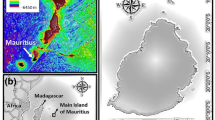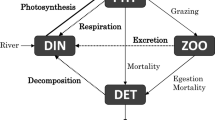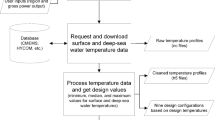Abstract
Ocean thermal energy conversion (OTEC) is a power generation technology that extracts energy from the temperature difference between deep seawater and surface water in the ocean. Currently, a 100 kW class OTEC demonstration project is underway on Kume Island, Okinawa, and a plan to increase water intake and introduce a 1 MW class OTEC plant is under consideration. Year-round generation of electricity by an OTEC plant requires that it be installed in tropical and subtropical regions, where the surface water has a high temperature and low nutrient content. However, the water discharged from an OTEC plant will have the opposite characteristics of low water temperature and high nutrients, as well as a low pH. One of the most concerning environmental impacts of this discharged water is its influence on corals, which are important species in tropical and subtropical marine ecosystems. In this study, we developed an ecosystem model for a subtropical shallow-water region; the model combines a pelagic submodel, a chemical equilibrium submodel, and a benthic submodel, and successfully reproduces the observed variation in pH. The model was used to predict the environmental impact of water discharged from OTEC plant. The simulation results suggest that a 1 MW class OTEC plant would cause few environmental changes that would affect corals.
Similar content being viewed by others
References
Kondo J ed (2015)Utilization technology for marine Energy - Power generation mechanisms and examples, Morikita Publishing Co., Ltd, 176pp (in Japanese).
Fujita RA, Markham J, Diaz Diaz J, Garcia JRM, Greenfield P, Black P, Aguilera S (2012) Revisiting ocean thermal energy conversion. Mar Policy 36:463–465
Kumejima-Town (2011) Basic research report on multiple utilization of Kumejima deep seawater, 190 pp (in Japanese)
Kleypas J, Feely R, Fabry V, Langdon C, Sabine C, Robbins L (2006) Impacts of ocean acidification on coral reefs and other marine calcifiers: a guide for future research. Report of workshop, sponsored by NSF, NOAA, and the U.S. Geological Survey
Anthony KR, Kline DI, Diaz-Pulido G, Dove S, Hoegh-Guldberg O (2008) Ocean acidification causes bleaching and productivity loss in coral reef builders. Proc Nat Acad Sci USA 105:17442–17446
Movilla J, Calvo E, Pelejero C, Coma R, Serrano E, Fernández-Vallejo P, Ribes M (2012) Calcification reduction and recovery in native and non-native Mediterranean corals in response to ocean acidification. J Exp Mar Biol Ecol 438:144–153
Wijgerde T, Silva C, Scherders V, Bleijswijk J, Osinga R (2014) Coral calcification under daily oxygen saturation and pH dynamics reveals the important role of oxygen. Biol Open 3:489–493
Grandelli PE, Rocheleau G, Hamrick J, Church M, Powell B (2012) Modeling the physical and biochemical influence of ocean thermal energy conversion plant discharges into their adjacent waters. United States. https://doi.org/10.2172/1055480
Wang Z, Tabeta S (2017) Numerical simulations of ecosystem change due to discharged water from ocean thermal energy conversion plant. OCEANS 2017-Aberdeen, 1–5.
Kinoshita T, Tabeta S, Fujino M (2003) Numerical simulation of artificial purification system by using hydrostatic and FULL-3D combined model. In: Proceedings of ASME 2003 22nd International Conference on Offshore Mechanics and Arctic Engineering, 1, 743–747
Mizumukai K, Sato T, Tabeta S, Kitazawa D (2008) Numerical studies on ecological effects of artificial mixing of surface and bottom waters in density stratification in semi-enclosed bay and open sea. Ecol Model 214:251–270
Kishi M, Ito S, Megrey B, Rose K, Werner F (2011) A review of the NEMURO and NEMURO.FISH models and their application to marine ecosystem investigations. J Oceanogr 67:3–16
Yamanaka Y, Yoshie N, Fujii M, Aita M, Kishi M (2004) An ecosystem model coupled with nitrogen-silicon-carbon cycles applied to Station A7 in the Northwestern Pacific. J Oceanogr 60:227–241
Lewis E, Wallace D (1998) Program Developed for CO2 System Calculations; Oak Ridge National Laboratory: Oak Ridge, TN. http://cdiac.ornl.gov/ftp/co2sys/
Feely RA, Sabine CL, Lee K, Berelson W, Kleypas J, Fabry VJ, Millero FJ (2004) Impact of anthropogenic CO2 on the CaCO3 system in the oceans. Science 305:362–366
Kuroyanagi A, Kawahata H, Suzuki A, Fujita K, Irie T (2009) Impacts of ocean acidification on large benthic foraminifers: results from laboratory experiments. Marine Micropaleontol 73:190–195
Dickson AG, Millero FJ (1987) A comparison of the equilibrium constants for the dissociation of carbonic acid in seawater media. Deep Sea Res Part A Oceanogr Res Pap 34(10):1733–1743
Uppstrom LR (1974) The boron/chlorinity ratio of deep-sea water from the Pacific Ocean. Deep Sea Res 21:161–162
Hofmann GE, Smith JE, Johnson KS et al (2011) High-frequency dynamics of ocean pH: a multi-ecosystem comparison. PLoS ONE 6:e28983
Santos I, Glud R, Maher D, Erler D, Eyre B (2011) Diel coral reef acidification driven by porewater advection in permeable carbonate sands, Heron Island. Great Barrier Reef Geophys Res Lett 38:L03604
Kleypas JA, Anthony KN, Gattuso J (2011) Coral reefs modify their seawater carbon chemistry–case study from a barrier reef (Moorea, French Polynesia). Glob Chang Biol 17:3667–3678
Anthony KN, Kleypas JA, Gattuso J (2011) Coral reefs modify their seawater carbon chemistry–implications for impacts of ocean acidification. Glob Chang Biol 17:3655–3666
Mongin M, Baird M (2014) The interacting effects of photosynthesis, calcification and water circulation on carbon chemistry variability on a coral reef flat: a modelling study. Ecol Model 284:19–34
Nakamura T, Nakamori T (2007) A geochemical model for coral reef formation. Coral Reefs 26:741–755
Atkinson MJ, Smith SV (1983) C: N: P ratios of benthic marine plants. Limnol Oceanogr 28:568–574
Darwin C (1842) The structure and distribution of coral reefs. Being the First Part of the Geology of the Voyage of the Beagle, under the Command of Capt. Fitzroy, R.N. during the Years 1832 to 1836. Smith Elder.
Mumby PJ, Steneck RS (2018) Paradigm lost: dynamic nutrients and missing detritus on coral reefs. Bioscience 68:7
Tanaka Y, Grottolib AG, Matsuib Y, Suzukic A, Sakai K (2015) Partitioning of nitrogen sources to algal endosymbionts of corals with long-term15N-labelling and a mixing model. Ecol Model 309:163–169
Tanaka Y, Suzuki A, Sakai K (2018) The stoichiometry of coral-dinoflagellate symbiosis: carbon and nitrogen cycles are balanced in the recycling and double translocation system. ISME J 12:860–868
de Goeij JM, van Oevelen D, Vermeij MJA, Osinga R, Middelburg JJ, de Goeij APFM, Admiraal W (2013) Surviving in a marine desert: the sponge-loop retains resources within coral reefs. Science 342:108–110
McMurray SE, Stubler AD, Erwin PM, Finelli CM, Pawlik JR (2018) A test of the sponge-loop hypothesis for emergent Caribbean reef sponges. Mar Ecol Prog Ser 588:1–14
Mueller B, den Haan J, Visser PM, Vermeij MJA, van Duyl FC (2016) Effect of light and nutrient availability on the release of dissolved organic carbon (DOC) by Caribbean turf algae. Sci Rep 6:18715
Rix L, de Goeij JM, Mueller CE, Struck U, Middelburg JJ, van Duyl FC, Al-Horani FA, Wild C, Naumann MS, van Oevelen D (2016) Coral mucus fuels the sponge loop in warm- and cold-water coral reef ecosystems. Sci Rep 6:18715
Xiong X, Matsuda Y, Hashioka T, Ono T, Yamanaka Y (2015) Effect of seasonal change in gas transfer coefficient on air–sea CO2 flux in the western North Pacific. J Oceanogr 71:685–701
Weiss RF (1974) Carbon dioxide in water and seawater: the solubility of a non-ideal gas. Mar Chem 2:203–215
Wanninkhof R (1992) Relationship between wind speed and gas exchange over the ocean revisited. Limnol Oceanogr 12:351–362
Fujii T (2017) CO2 dynamics of the atmosphere and surface seawater in coastal zone. J Jpn Assoc Hydrolog Sci 47(2):107–118
Pan Y, You L, Li Y, Fan W, Chen CA, Wang B, Chen Y (2018) Achieving highly efficient atmospheric CO2 uptake by artificial upwelling. Sustainability 10:664. https://doi.org/10.3390/su10030664
HOT-DOGS (Hawaii Ocean Time-series Data Organization & Graphical System), http://hahana.soest.hawaii.edu/hot/hot-dogs/bdisplay.html
Oshimi R (2019) Environmental impact prediction of discharged water from OTEC plant. (Unpublished master’s thesis), The University of Tokyo
Keir RS (1983) Variation in the carbonate reactivity of deep-sea sediments: determination from flux experiments. Deep Sea Res 30:279–296
Sulpisa O, Lixa C, Muccia A, Boudreaub BP (2017) Calcite dissolution kinetics at the sediment-water interface in natural seawater. Mar Chem 195:70–83
Bell PR, Elmetri I (1995) Ecological indicators of large-scale eutrophication in the Great Barrier Reef lagoon. Oceanogr Lit Rev 12(42):1145
Costa OS, Leao Z, Nimmo M, Attrill M (2000) Nutrification impacts on coral reefs from northern Bahia, Brazil. Hydrobiologia 440:307–315
Kleypas JA, McManus JW, Menez LAB (1999) Environmental limits to coral reef development: where do we draw the line? Am Zool 39:146–159
Fabricius KE, Langdon C, Uthicke S, Humphrey C, Noonan S, G. De’ath, R. Okazaki, M. Nancy, M. Glas, and J. Lough, (2011) Losers and winners in coral reefs acclimatized to elevated carbon dioxide concentrations. Nat Clim Change 1:165–169
Acknowledgements
This research was partially supported by JSPS KAKENHI (Grant 15H04210).
Author information
Authors and Affiliations
Corresponding author
Additional information
Publisher's Note
Springer Nature remains neutral with regard to jurisdictional claims in published maps and institutional affiliations.
About this article
Cite this article
Oshimi, R., Tabeta, S. & Mizuno, K. Water quality modeling in subtropical shallow waters to predict environmental impacts of ocean thermal energy conversion. J Mar Sci Technol 27, 335–347 (2022). https://doi.org/10.1007/s00773-021-00837-7
Received:
Accepted:
Published:
Issue Date:
DOI: https://doi.org/10.1007/s00773-021-00837-7













